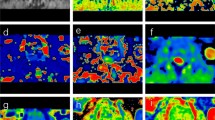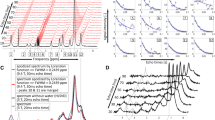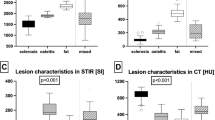Abstract
Objectives
To evaluate the effectiveness of the iterative decomposition of water and fat with echo asymmetric and least-squares estimation (IDEAL) MRI to quantify tumour infiltration into the lumbar vertebrae in myeloma patients without visible focal lesions.
Methods
The lumbar spine was examined with 3 T MRI in 24 patients with multiple myeloma and in 26 controls. The fat-signal fraction was calculated as the mean value from three vertebral bodies. A post hoc test was used to compare the fat-signal fraction in controls and patients with monoclonal gammopathy of undetermined significance (MGUS), asymptomatic myeloma or symptomatic myeloma. Differences were considered significant at P < 0.05. The fat-signal fraction and β2-microglobulin-to-albumin ratio were entered into the discriminant analysis.
Results
Fat-signal fractions were significantly lower in patients with symptomatic myelomas (43.9 ±19.7%, P < 0.01) than in the other three groups. Discriminant analysis showed that 22 of the 24 patients (92%) were correctly classified into symptomatic or non-symptomatic myeloma groups.
Conclusions
Fat quantification using the IDEAL sequence in MRI was significantly different when comparing patients with symptomatic myeloma and those with asymptomatic myeloma. The fat-signal fraction and β2-microglobulin-to-albumin ratio facilitated discrimination of symptomatic myeloma from non-symptomatic myeloma in patients without focal bone lesions.
Key Points
• A new magnetic resonance technique (IDEAL) offers new insights in multiple myeloma.
• Fat-signal fractions were lower in patients with symptomatic myelomas than in those with asymptomatic myelomas.
• The β2-microglobulin-to-albumin ratio also aided discrimination of symptomatic myeloma.
• The fat-signal fraction may provide information about the myeloma cell mass.





Similar content being viewed by others
References
Durie BG, Kyle RA, Belch A et al (2003) Myeloma management guidelines: a consensus report from the Scientific Advisors of the International Myeloma Foundation. Hematol J 4:379–398
Smith A, Wisloff F, Samson D (2005) Guidelines on the diagnosis and management of multiple myeloma 2005. Br J Haematol 132:410–451
Hjorth M, Hellquist L, Holmberg E et al (1993) Initial versus deferred melphalan-prednisone therapy for asymptomatic multiple myeloma stage I – a randomized study. Myeloma Group of Western Sweden. Eur J Haematol 50:95–102
Riccardi A, Mora O, Tinelli C et al (2000) Long-term survival of stage I multiple myeloma given chemotherapy just after diagnosis or at progression of the disease: A multicentre randomized study. Br J Cancer 82:1254–1260
Modic MT, Obuchowski N (2004) Whole-body CT screening for cancer and coronary disease: does it pass the test? Cleveland Clin J Med 71:47–56
Durie BG, Waxman AD, D’Agnolo A et al (2002) Whole Body F-FDG PET identifies high-risk myeloma. J Nucl Med 43:1457–1463
Hutton MJ, Bayer JH, Powell J, Sharp DJ et al (2011) Modic vertebral body changes: The natural history as assessed by consecutive magnetic resonance imaging. Spine (Phila Pa 1976). Feb 25. doi:10.1097/BRS.0b013e31821604b6
Reeder SB, Wen Z, Yu H et al (2004) Multicoil Dixon chemical species separation with an iterative least-squares estimation method. Magn Reson Med 51:35–45
Reeder SB, Pineda AR, Wen Z et al (2005) Iterative decomposition of water and fat with echo asymmetry and least-squares estimation (IDEAL): application with fast spin-echo imaging. Magn Reson Med 54:636–644
Gerdes CM, Kijowski R, Reeder SB et al (2007) IDEAL imaging of the musculoskeletal system: robust water fat separation for uniform fat suppression, marrow evaluation, and cartilage imaging. AJR Am J Roentgenol 189:W284–W291
Yu H, Reeder SB, Shimakawa A et al (2004) Implementation and noise analysis of chemical shift correction for fast spin echo Dixon imaging. (abstr) The International Society of Magnetic Resonance 12th annual meeting book of abstracts. Berkeley, CA: International Society of Magnetic Resonance May:2686
International Myeloma Working Group (2003) Criteria for the classification of monoclonal gammopathies, multiple myeloma and related disorders: a report of the International Myeloma Working Group. Br J Haematol 121:749–757
Genant HK, Wu CY, van Kuijk C et al (1993) Vertebral fracture assessment using a semi-quantitative technique. J Bone Miner Res 8:1137–1148
Otake S, Mayr NA, Ueda T et al (2002) Radiation-induced changes in MR signal intensity and contrast enhancement of lumbosacral vertebrae: do changes occur only inside the radiation therapy field? Radiology 222:179–183
Yu H, Shimakawa A, McKenzie CA et al (2008) IDEAL water-fat decomposition with multipeak fat spectral modeling. Magn Res Med 60:1122–1134
Bydder M, Liang Y, Yu H et al (2010) Monitoring bone marrow changes during chemoradiotherapy using MRI fat quantification. (abstr) The International Society of Magnetic Resonance 18th annual meeting book of abstracts. Berkeley, CA: International Society of Magnetic Resonance May:2882
Hwang IH, Chung JS, Shin HJ et al (2011) Predictive value of post-transplant bone marrow plasma cell percent in multiple myeloma patients undergone autologous transplantation. Korean J Intern Med 26:76–81
Dixon WT (1984) Simple proton spectroscopic imaging. Radiology 153:189–194
Reeder SB, McKenzie CA, Pineda AR et al (2007) Water-fat separation with IDEAL gradient-echo imaging. J Magn Reson Imaging 25:644–652
Yu H, Shimakawa A, McKenzie CA, Brodsky E (2008) Multiecho water-fat separation and simultaneous R2* estimation with multifrequency fat spectrum modeling. Magn Reson Med Nov 60:1122–1134
Reeder SB, Robson PM, Yu H et al (2009) Quantification of hepatic steatosis with MRI: the effects of accurate fat spectral modeling. J Magn Reson Imaging 29:1332–1339
Yu H, Shimakawa A, Reeder S et al (2009) Magnitude fitting following phase sensitive water-fat separation to remove effects of phase errors (abstr). In: Proceedings of the Seventeenth Meeting of the International Society for Magnetic Resonance in Medicine. Berkeley, Calif: International Society for Magnetic Resonance in Medicine, 461.
Stäbler A, Baur A, Bartl R et al (1996) Contrast enhancement and quantitative signal analysis in MR imaging of multiple myeloma: assessment of focal and diffuse growth patterns in marrow correlated with biopsies and survival rates. AJR Am J Roentgenol 167:1029–1036
Durie BG (2006) The role of anatomic and functional staging in myeloma: Description of Durie/Salmon plus staging system. Eur J Cancer 42:1539–1543
Terpos E, Berenson J, Cook RJ et al (2010) Prognostic variables for survival and skeletal complications in patients with multiple myeloma osteolytic bone disease. Leukemia 24:1043–1049
Barlogie B, Bolejack V, Schell M et al (2010) Prognostic factor analyses of myeloma survival with intergroup trial S9321 (INT 0141): examining whether different variables govern different time segments of survival. Ann Hematol 90:423–428
Dimopoulos M, Kyle R, Fermand JP et al (2011) Consensus recommendations for standard investigative workup: report of the International Myeloma Workshop Consensus Panel 3. Blood 117:4701–4705
Larsen JT, Chee CE, Lust JA et al (2011) Reduction in plasma cell proliferation after initial therapy in newly diagnosed multiple myeloma measures treatment response and predicts improved survival. Blood 118:2702–2707
Ricci C, Cova M, Kang YS et al (1990) Normal age-related patterns of cellular and fatty bone marrow distribution in the axial skeleton: MR imaging study. Radiology 177:83–88
Acknowledgement
M.T. was funded by the Tsuchiya Foundation (Japan) through an unrestricted research grant.
Author information
Authors and Affiliations
Corresponding author
Electronic supplementary material
Below is the link to the electronic supplementary material.
Supplemental Material 1
(DOC 29 kb)
Supplemental Material Fig. 1a
(JPEG 7 kb)
Supplemental Material Fig. 1b
(JPEG 5 kb)
Supplemental Material Fig. 1c
(JPEG 8 kb)
Supplemental Material Fig. 1d
(JPEG 43 kb)
Supplemental Material Fig. 2
(JPEG 53 kb)
Rights and permissions
About this article
Cite this article
Takasu, M., Tani, C., Sakoda, Y. et al. Iterative decomposition of water and fat with echo asymmetry and least-squares estimation (IDEAL) imaging of multiple myeloma: initial clinical efficiency results. Eur Radiol 22, 1114–1121 (2012). https://doi.org/10.1007/s00330-011-2351-8
Received:
Revised:
Accepted:
Published:
Issue Date:
DOI: https://doi.org/10.1007/s00330-011-2351-8




